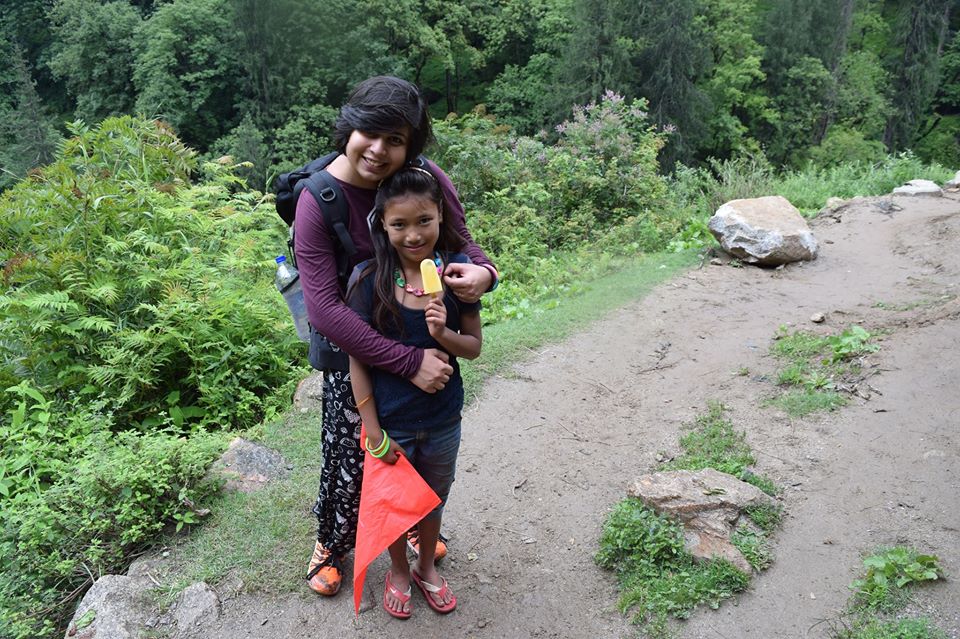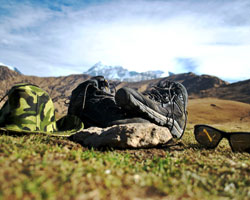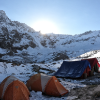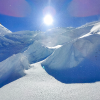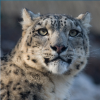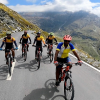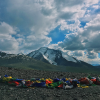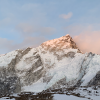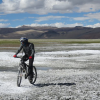Kuari Pass is not just another winter trek.
Sure you get to enjoy snowfall and build a snowman like on any winter trek. But what you also get on this trek is views of the countless revered peaks of the Garhwal Range of Himalayas that attract mountaineers and climbing enthusiasts from all over the world. And the best part is that they don’t make you wait – the peaks start to reveal themselves from the first day onwards and stay up until the very end. The feeling of being surrounded by all these peaks is a feeling that’s hard to describe in words.
Let’s look at some of the most important peaks you see from Kuari Pass:
1. Mt. Dronagiri/ Dunagiri (7,066 m)
This magnificent peak is the curtain-raiser. You see Mt. Dunagiri peeking from behind a layer of peaks as you reach Joshimath. It stays around till the very last day of the trek which also makes it the show-stopper.
Apart from its elevation, what makes this high mountain even more intriguing is that it hides within its folds the infamous Sanjeevani Booti, the plant that features in Ramayana and is known to ‘infuse life’. According to the story, Hanuman went in search of this live-saving herb in order to cure Lakshman who was hit by an arrow in his fight with Maghnada and had fallen unconscious. Hanuman, being Hanuman, could not locate the particular herb which he was asked to bring back, so he plucked the entire mountain out and flew it back to where Laxman was being treated. It worked out okay in the end because Lakshman was revived! But the villagers in the area have not forgiven Hanuman to this day for defacing their holy mountain; they refuse to worship him even today.
Many medical expeditions have been launched to this mountain in search of this life-inducing drug. Even though many of the expeditions were successful by the way of summiting the mountain, the search for this herb is yet to yield any fruit.
P.C: Janmenjoy Roy

2. Nanda Devi (7,816 m)
Nanda Devi has some impressive credentials. It is the second highest peak of India and the first highest that lies fully within the Indian Territory. At some point it was even considered the highest mountain in the world. The mountain is kind enough to show itself right on Day 1 as you start your trek from Auli.
Nanda Devi is named after the Hindu goddess Parvati, who is also known as Nanda. According to Hindu mythology, Nanda Devi is considered the daughter of Himavat (the personification of the Himalayas) and Mena. She is believed to be an incarnation of the goddess Parvati and is revered as the guardian deity of the region.
The trail of Kuari Pass goes through the Nanda Devi Sanctuary which is a high-altitude glacial basin surrounded by a ring of peaks, including Nanda Devi itself. This region is considered highly sacred and is often referred to as the ‘Inner Sanctuary’. Local folklore and beliefs suggest that it is the abode of the goddess Nanda Devi; entry into this sanctuary was restricted for many years to protect its sanctity and fragile ecosystem.
According to local legends, the Nanda Devi peak was once adorned with a beautiful necklace made of precious jewels. One day, the necklace broke, and the jewels scattered across the Himalayas, forming other mountain peaks. This story explains the presence of numerous peaks in the region and underscores the divinity and grace of Nanda Devi. Interesting, no?
Even amongst all the peaks scattered around this mountain, you will be able to identify Nanda Devi for its very peculiar shape- the steep slopes of this mountain make it one of the toughest peaks to climb.

3. Hathi-Ghori Parbat (6,727 m and 6,708 m respectively)
These are probably two of the easiest peaks to spot and identify since they are so true to their name. Hathi Ghora stand next to each other and are shaped exactly like the head of an elephant and a horse – if you don’t see the shapes, squint a little and tilt your head to one side, that should do the trick! Once you see it, you can’t ever unsee it!
You’ll get the best views of these peaks from the Khulara campsite as they stand proud and tall right outside the opening of your tent.

4. Chaukhamba (7,138 m)
This huge mountain massif comprising of 4 mountain peaks, is hard to miss from the campsite of Gelghad, when the skies are clear. In the morning, the massif turns a bright golden with the first rays of the sun; the view is absolutely spellbinding.
Part of the Gangotri group of Garhwal Himalayas, the highest of the four, Chaukhamba I at 7,138M was first climbed successfully in the year 1952.

5. Neelkanth (6,597 m)
Next to Chaukhamba Massif lies one of the most revered peaks in Hindu mythology, Neelkanth. Satopanth Glacier lies on the north-west side of this mountain which was first successfully summited in 1974 after various failed attempts.
The story of the birth of this mountain goes something like this. It is said that the spot where the mountain stands today was flat, a route which connected Kedarnath and Badrinath through fairly even ground. A worshipper would visit both these temples on the same day, every day, for a long time. But once upon a time, Shiva, known for his raging anger got furious at the worshipper for some of his sins. The lord is then, known to have erected this towering mountain in order to block the worshipper’s way. This mountain, now known as Neelkanth, stands between Badrinath and Kedarnath disallowing any direct passage between the two places.
P.C: Ayan Bhuin

These are only a few of the hundreds of mountains you witness of the trek. If you also decide to combine your trek with Pangarchulla, some of the mountains cheering you on on your journey would be Kamet, Mana, Mandir, Barmatia, Lampak I and II.

You also get a glimpse of Mt. Trishul (7,120 m) and Nandaghunti (6,309 m) en route Pangarchulla Peak. Though the view may not be as great as one gets to see on Roopkund Trek.

Getting acquainted with some of the highest peaks in the range is only one of the many reasons why clubbing the two treks – Kuari and Pangarchulla – is a brilliant idea. Curious what the other reasons are? Read, Why Kuari Pass & Pangarchulla Trek itinerary is high on ROI.
See you up there!
This article was originally written by Dhaarna Kukreja on 23-11-2017.
It was edited and updated by Neeti Singhal on 15-11-2023.
